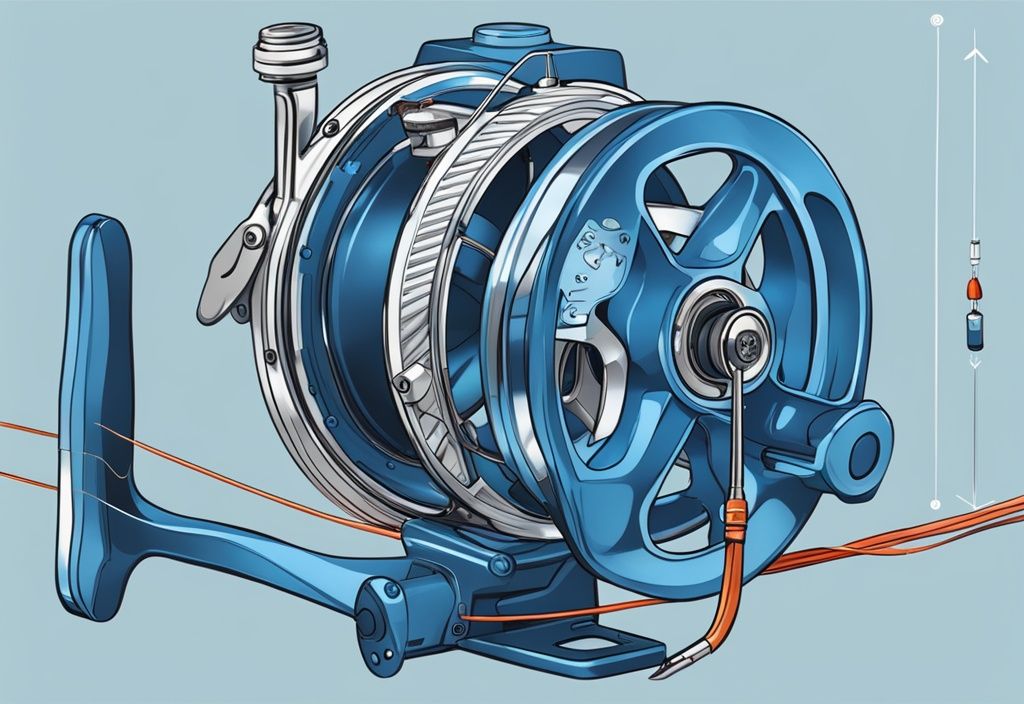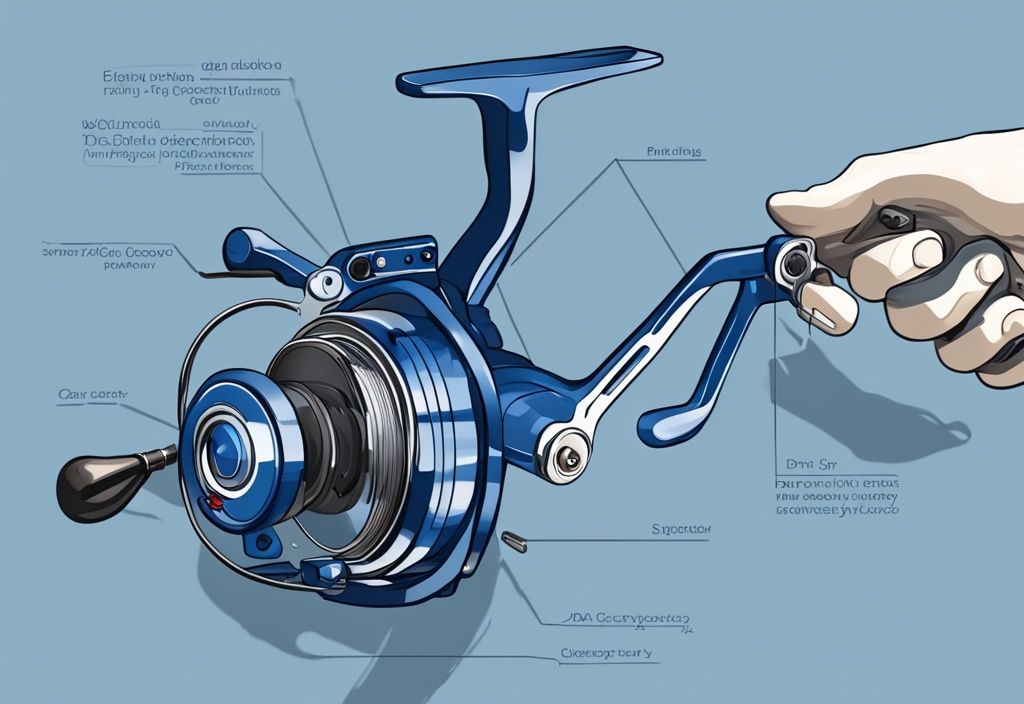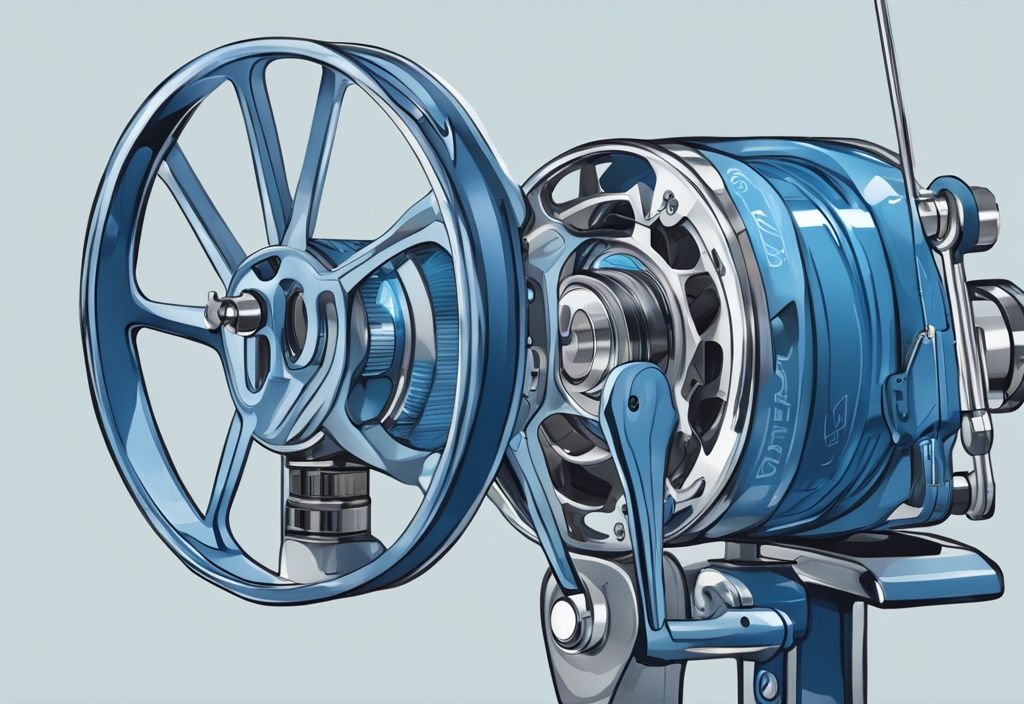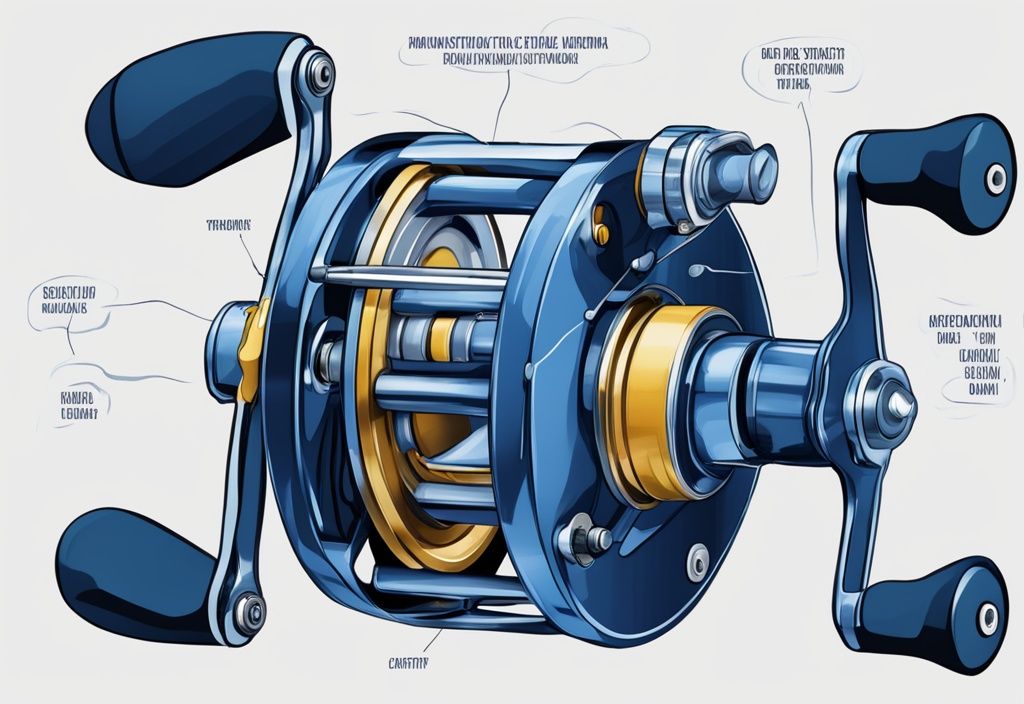How many fish have you lost just because you didn’t know about max drag on a fishing reel? Ever wondered what that term precisely meant? Well, as an angler with over two decades of fishing experience, let me get you in on the secret. Max drag is, without a shred of doubt, a game-changer in the world of angling. It’s the crux of how much resistance your reel can handle before it surrenders to the heavyweight champ on the other end of your line.
In this article, we’ll explore the nitty-gritty of max drag, how it impacts your battle with the big ones, and why understanding it is essential to step up your fishing game. Trust me, right gear selection and a healthier reel-life depend on the concept of max drag.
So sit back, relax, and get ready to reel in some heavyweight knowledge that’s sure to make your next trip a grand success. Remember, a good angler never stops learning!
The Concept of Max Drag
Understanding what max drag means on a fishing reel is fundamental for any angler aiming to enhance their fishing game. Let’s dive into this crucial aspect through Jake Marlin’s seasoned perspective.
Max Drag Explained: What Does It Mean?
So, what does max drag mean on a fishing reel? Picture yourself in an epic battle with a hefty fish. Max drag is that lifeline — the maximum resistance your reel can muster against the line’s pull during this thrilling showdown. It’s the barricade stopping the line from snapping and your reel from giving in under fierce pressure. This resistance comes from the drag washers nestled inside the reel, managing the friction that dictates how smoothly the line eases out.
Max drag is quantified in pounds, essentially showcasing the upper limit of force or tension the line is built to handle. The higher the max drag, the sturdier the opponent you can aim for. Imagine going after a mighty marlin or a tenacious tuna; a robust max drag is your ticket to safely engage these magnificent creatures. It’s all about giving you the edge to effectively and responsibly reel in those big catches, making your fishing gear choice sharper and more strategic.
Why is Max Drag Important in Fishing?
Grasping the importance of max drag can be a game-changer. It grants you mastery over how much resistance your quarry faces as it struggles against the line. This control is like setting the difficulty level in a game, providing just the right challenge to make the encounter fair yet thrilling. Selecting the appropriate max drag is pivotal when gearing up for different environments and fish species. Getting it right ensures your line and reel remain unscathed during those heart-pounding moments.
Moreover, properly set drag nurtures more ethical fishing practices.
It minimizes undue stress on the fish, increasing the chances of a healthy release if you practice catch and release. Ensuring your reel can endure the pressure from a battling fish not only amps up your success rate but also ties into the respect and responsibility we owe to our aquatic adversaries. With max drag fine-tuned, you’re all set for a responsible, victorious, and exhilarating fishing escapade.
How Does Max Drag Function on a Reel?
The Mechanics behind Drag Systems
The mechanics of a drag system revolve around the intricate dance of pressure and friction applied to the drag washers within the reel. Picture this: as a tenacious fish fights with all its might, the pressure shifts, altering the resistance the fish feels. This is what controls the intensity of the battle. The magic lies in the torque equation—where torque equals force times radius.
As the amount of line on the spool increases, the radius decreases, thereby reducing the exerted drag. It’s a dynamic balance that’s crucial for mastering fishing finesse. When you get this right, you’re not just using the drag system; you’re wielding it like a seasoned pro.
Drag Washers and Surface Area: Their Role in Max Drag
Ever wondered why drag washers are such a big deal? It all comes down to surface area. By bumping up the surface area—either with larger washers or more of them—you significantly enhance the drag capacity. Imagine fighting a monster fish with washers that are top-notch in quality and material.
High-quality drag washers ensure smooth and consistent resistance. This is key when you’re up against those vigorous tugs and pulls from a determined fish. Investing in effective drag washers means each cast, each fight, becomes manageable and, ultimately, more successful.

Guide to Properly Setting the Drag
Start with the fundamentals when learning about what max drag means on a fishing reel, to ensure a smooth, successful experience on the water.
How to Adjust Your Reel’s Max Drag
Setting the drag on your fishing reel is a critical step that keeps the tension balanced and prevents line breaks or reel failure. A good rule of thumb: set your drag to one-quarter to one-third of the line’s breaking strength. This fine-tuning allows you to control the fish without overworking your gear.
Imagine starting the adjustment process with a fully loaded spool. The drag will increase as the spool diameter decreases, so you’ll want to be precise. Understanding fishing techniques, such as what a drop shot is in fishing, can also enhance your overall angling experience. Grab a fishing scale to measure the drag pressure accurately—secure the line to the scale, pull gently, and tinker with the drag knob until the scale shows the desired pressure. Easy as casting a line on a calm morning. If you’re planning a fishing trip, consider checking out our guide on the best 10 fishing pontoons for a perfect experience.
Considerations When Setting Your Drag
Think of setting your max drag like preparing a gourmet meal—every detail matters. Your drag should match the line strength and the type of fish you’re after. Understanding your fishing conditions and techniques is crucial, as fishing in open water demands different drag settings than angling in areas with lots of cover or structures.
Don’t crank the drag too high, as it may lead to line breakage or reel failure due to excessive heat and friction. During the fight, fine-tune the drag to keep it balanced, preventing sudden snaps. These small tweaks can turn the tide between landing a trophy fish and a heartbreaking break-off.
Integrating these practices, you’ll grasp what does max drag mean on a fishing reel and apply it effectively for a rewarding, sustainable fishing adventure. Every turn of the knob and flick of the wrist brings you one step closer to mastering your gear and savoring the thrill of the catch.
Practical Uses of Max Drag in Fishing
The subheadings below cover critical situations and preventive measures where understanding the max drag on your fishing reel can make or break your fishing experience. Whether you’re facing a hard-fighting fish or ensuring your gear lasts longer, these insights are essential.
Situations Where High Max Drag is Essential
Knowing what does max drag mean on a fishing reel is absolutely crucial for certain fishing scenarios that demand high resistance. Imagine you’ve got a hefty fish on the line—ever tried reeling in a dead weight or stopping a monster fish from dashing into the rocks? That’s where high max drag makes all the difference. You can haul that giant in without letting it tangle your line around obstacles.
In those moments when you’re targeting big, powerful fish under tough conditions, high max drag is indispensable. It gives you the leverage to apply significant resistance, making sure you’ve got that fish under control and tipping the odds of a successful catch in your favor. Even in competitive or professional fishing, high max drag settings are your secret weapon. Precision in managing line resistance can be a game-changer, offering you greater control and power—key ingredients for top-notch fishing performance.
How Max Drag Can Prevent Reel Damage
Setting the max drag on your fishing reel correctly isn’t just about catching fish—it’s about maintaining your gear in prime condition. A well-adjusted max drag means your reel components aren’t taking on excessive stress, which can lead to wear and tear over time. You wouldn’t want your trusty reel to give out on you, would you?
By managing the pressure on the drag washers, you can prevent the drag system from overheating and reduce the risk of friction damage. Balanced drag settings help spread the mechanical stress between you and the fish during a fight, which is not only good for your gear but also makes for smoother, more efficient operation. This way, both the longevity of your reel and the quality of your fishing experience are significantly enhanced. Understanding what does max drag mean on a fishing reel can make a crucial difference in both your gear’s durability and your success on the water.

Understanding Different Drag Systems
Front Drag Systems: An Overview
Front drag systems are the powerhouse in a fishing reel’s arsenal, reputed for their remarkable strength and impeccable durability. They’re specifically designed for heavy-duty fishing scenarios where anglers must contend with fish that put up quite a fight.
Positioned right at the front of the reel, front drag systems feature larger and more robust drag washers. These washers ensure exceptional resistance and effective heat dissipation, which is crucial when a fish is making a run. This design usually means you get smoother and more precise drag adjustments, allowing you to fine-tune the resistance on your line with great accuracy. This becomes essential, especially when you’re out targeting those hefty, stubborn fish.
The strategic location of the front drag system, close to the spool, significantly enhances control and reliability. It’s a mechanical advantage that serious anglers cannot overlook. For those who need to fully grasp what max drag means on a fishing reel, the front drag system’s ability to handle more significant resistance makes it the go-to choice when pursuing larger aquatic adversaries.
Rear Drag Systems: What You Need to Know
Let’s talk about the rear drag systems next. These are often celebrated for their user-friendly nature, making them the darling of anglers who value convenience.
The key feature of rear drag systems is their easy-to-access adjustment knobs located at the rear of the reel. This placement makes it a breeze to tweak settings on the fly without having to interrupt your fishing flow. Although, with this convenience comes a trade-off. Rear drag systems aren’t typically as robust or durable as their front-mounted counterparts. So, when you’re wrestling with larger, more vigorous fish, these systems might leave you wanting more in terms of raw power and resilience.
Despite these drawbacks, the rear drag system shines in situations demanding quick adjustments and nimble handling. Picture this: you’re out on the water, and a fish suddenly changes direction. With a rear drag system, it’s a simple task to make rapid tweaks to your drag settings, ensuring you’re always in control.
In essence, rear drag systems offer a blend of practicality and flexibility—perfect for those moments when swift response matters more than brute strength. For anglers who cherish these qualities, understanding what max drag means on a fishing reel becomes a vital part of optimizing their gear for the perfect catch.
The Relationship Between Max Drag and Line Strength
Matching Drag with Your Line Strength: A Must-Know
Understanding what does max drag mean on a fishing reel is crucial when matching it with your line strength. It ensures that the tension applied does not exceed the breaking point of the line, preventing catastrophic failures. A well-matched drag and line strength mean that even under the high stress of a fish fight, the line remains intact.
Remember, exceeding the appropriate drag setting can cause the line to snap due to the overwhelming force it can’t handle. Factors like knot strength and friction also play a significant role, often allowing the line to tolerate higher tensions. Therefore, setting the drag correctly according to your line’s strength is essential for maintaining line integrity and ensuring successful catches.
How Line Type and Knot Strength Influence Max Drag
The type of line you use deeply impacts the effectiveness and performance of your reel’s max drag. Monofilament, fluorocarbon, and braid lines each exhibit unique characteristics in terms of stretch and sensitivity.
- Monofilament lines are known for their elasticity, which can absorb sudden pulls but may limit sensitivity.
- Fluorocarbon lines offer less stretch, providing better sensitivity and strength.
- Braid lines exhibit minimal stretch and high sensitivity.
Knot strength is another critical factor influencing how much drag your line can endure. Typically, knots only retain about 60% to 80% of the line’s break strength, which means a poorly tied knot can significantly reduce your line’s effective strength. Consequently, proper knot-tying techniques and frequent inspections are necessary to maintain optimal performance.
For PE lines, while they offer remarkable strength under straight tension, their vulnerability to friction means careful drag management is paramount. It’s essential to account for these variations, ensuring that your drag setting complements the line type and knot strength for maximum efficiency and safety. Understanding the correlation between line type, knot strength, and max drag ensures that your equipment operates within its limits, enhancing your overall fishing experience.

Max Drag: Considerations and Precautions
Max drag settings on a fishing reel aren’t just numbers; they are a crucial aspect of angling that can determine the outcome of a fishing expedition. They come with their own set of considerations and precautions that every angler should be aware of.
The Risk of Exhaustion: Another Side of Max Drag
Ever felt that burn in your arms after a long battle with a feisty fish? Higher drag settings can really expedite an angler’s exhaustion, especially if you’re not using proper techniques or supportive harnesses. Imagine wrestling with a fish under high max drag; it’s like arm wrestling on repeat! This physical strain can lead to fatigue, resulting in mistakes when you least need them. While pros might crank up that drag to reel in a monster catch, the average angler needs to recognize their physical limits. Striking a balance between endurance and technique is the sweet spot, preventing exhaustion from ruining what’s supposed to be an enjoyable fishing session.
Preventing Line and Reel Damage: What to Keep in Mind
Nothing’s worse than hearing that dreaded snap of your line or the grinding sound from an overworked reel. To avoid such nightmares, staying within the factory-specified drag settings is a must. Ignoring these limits can cause heat expansion and increase friction among drag components, leading to malfunction or, worse, breakage. You don’t want your reel turning into a hot mess, do you?
Properly spooling your line can make a world of difference, too. It minimizes friction and keeps your setup running smoothly, ensuring consistent performance. Another pro tip? Use a smoothly increasing drag curve. It helps forestall line snapping during those heart-pounding high-tension moments. By keeping these precautions in mind, you not only extend the durability and functionality of your gear, but you also set yourself up for a successful and enjoyable fishing experience. And that’s what it’s all about, right?
Frequently Asked Questions on Max Drag
Understanding max drag on a fishing reel can be the difference between landing that dream fish and telling tales of the one that got away. Let’s dive into some common questions every angler should know.
What Exactly is Max Drag on a Fishing Reel?
Imagine you’re out on the water, and that adrenaline-charged moment hits – a fish bites. Max drag is the maximum force or tension your reel’s drag system can apply to your fishing line without causing it to snap or your reel to give up on you. It’s like your best friend in keeping that line steady under pressure.
Setting The Max Drag: How is it Done?
Trust me, my friend, getting this right is crucial. You typically want to set the drag to about one-quarter to one-third of your line’s breaking strength. How do you do this? Grab a scale and measure the drag pressure as you adjust. This ensures that your reel performs consistently, no matter what.
Why Does Line Strength Need to Match Max Drag?
Ever watched a line snap and felt that pang of frustration? Matching your line strength with your max drag keeps those moments at bay. When your drag setting is aligned with your line’s capacity, it handles the pressure from your catch like a champ. Think of it as harmony between your gear and the fish.
Is a Higher Max Drag Always Advantageous?
Nope, and here’s why. Too much drag can wear you out, dull the action of your rod, and place unnecessary strain on your fishing gear. Picture yourself battling a tough fish, only for your gear to fail because it was overburdened. Balance is key here; it’s all about finding that sweet spot.
How Do I React if My Reel’s Drag System Fails?
Stay calm, and adapt quickly. Use your rod angle to manage the pressure and apply resistance with the reel handle manually. It’s like a dance, improvising to keep things under control. Address the issue swiftly to prevent long-term damage to your reel. Quick thinking saves the day.


